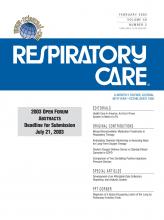Abstract
BACKGROUND: Appropriate identification of hypoxic patients with chronic obstructive pulmonary disease (COPD) is important because of the demonstrated survival benefit of long-term oxygen therapy (LTOT) and its associated cost. Resting oxygen saturation (measured via pulse oximetry [SpO2]) and lowest exercise SpO2 (during a 6-min walk test) is the standard method of determining LTOT requirements, but that method does not measure the patient's oxygenation during sleep or activities of daily living. We hypothesized that values obtained via the standard method would correlate poorly with values obtained via ambulatory oximetry monitoring.
METHODS: We conducted a prospective, cohort study in an out-patient pulmonary clinic in a tertiary care referral center, with 20 stable COPD patients who were being evaluated for LTOT with conventional evaluation versus 16-24 hours of ambulatory oximetry.
RESULTS: The resting SpO2 did not correlate well with mean ambulatory SpO2 (r = 0.64) or the percent of monitored time spent with SpO2 < 88% (r = 0.49). The lowest exercise SpO2 also did not predict mean ambulatory SpO2 (r = 0.39) or the percent of monitored time spent with SpO2 < 88% (r = 0.32). Conventional evaluation overestimated LTOT requirements with 16 of the 20 patients developing an SpO2 < 88%, most of them with exercise only (ie, most had normal resting SpO2). With ambulatory monitoring, however, only 3 of the 16 patients spent > 10% of the monitored time with SpO2 < 88%.
CONCLUSION: There was a poor relationship between the conventional oxygenation assessment method and continuous ambulatory oximetry during LTOT screening with COPD patients.
- long-term oxygen therapy
- lung disease
- chronic obstructive pulmonary disease
- COPD
- oxygen
- ambulatory oximetry
- monitoring
Footnotes
- Correspondence: Richard W Light MD, Department of Pulmonary Medicine, St Thomas Hospital, 4420 Harding Road, Nashville TN 37202. E-mail: rlight98{at}yahoo.com.
- Copyright © 2003 by Daedalus Enterprises Inc.







